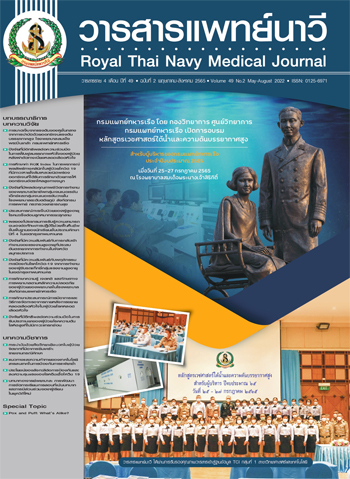Middle Ear Barotrauma in Hyperbaric Oxygen Therapy at Somdech Phra Pinklao Hospital, Naval Medical Department
Main Article Content
Abstract
Middle ear barotrauma is the most common complication from hyperbaric oxygen therapy. This is caused by the patient's inability to equalize the pressure between the middle ear and the environment. This is a retrospective study characterized by middle ear barotrauma occurred in 942 patients during their treatments in the hyperbaric center of Somdech Phra Pinklao hospital from 2018 to 2020. The results showed a prevalence of pressure-related middle ear injuries of 25.5% which mostly occurred in 54.2% of females, and 55% of those were found in elderlies age over 60 years old. It was also found out that 42.7% of barotrauma occured mostly during the first treatment and usually at depth of 1 - 10 feet (48.5%). It was recommended to provide more awareness of these factors, especially for female and elderly patients. Furthermore, preparing the patients by informing about the treatment, teaching the equalization techniques, and taking the physical examinations before the hyperbaric oxygen therapy are the most important key to screen the high-risk patient and to take preventative action for middle ear barotrauma.
Article Details

This work is licensed under a Creative Commons Attribution-NonCommercial-NoDerivatives 4.0 International License.
References
Nasole E, Zanon V, Marcolin P, Bosco G. Middle ear barotrauma during hyperbaric oxygen therapy: a review of occurrences in 5,962 patients. Undersea Hyperb Med 2019;46(2):101-6.
Komtae S, Prachusilpa G. Competency of hyperbaric nurse. Royal Thai Navy Medical Journal 2018;45(1):39-51. (in Thai).
Carlson S, Jones J, Brown M, Hess C. Prevention of hyperbaric associated middle ear barotrauma. Ann Emerg Med 1992;21(12):1468-71.
Grandjean B. Accidents barotraumatiques en caisson hyperbare. In: Wattel F, Mathieu D, editors. Traité de medicine hyperbare. Ellipses: Paris; 2002. p. 620-6.
Lima MAR, Farage L, Cury MCL, Júnior FB. Update on middle ear barotrauma after hyperbaric oxygen therapy-insights on pathophysiology. Int Arch Otorhinolaryngol 2014;18(2):204-9.
Karahatay S, Yilmaz YF, Birkent H, Ay H, Satar B. Middle ear barotrauma with hyperbaric oxygen therapy: incidence and the predictive value of the nine-step inflation/deflation test and otoscopy. Ear Nose Throat J 2008;87(12):684-8.
ONeill OJ, Brett K, Frank AJ. Middle ear barotrauma. StatPearls. [Internet]. 15 August 2021. [cited 2021 November 22]. Available from: https://www.ncbi.nlm.nih.gov/books/NBK499851/.
Sadé J, Ar A. Middle ear and auditory tube: middle ear clearance, gas exchange, and pressure regulation. Otolaryngol Head Neck Surg 1997;116(4):499-524.
Kim CH, Shin JE. Hemorrhage within the tympanic membrane without perforation. J Otolaryngol Head Neck Surg 2018;47(1):66.
Mallen JR, Roberts DS. SCUBA medicine for otolaryngologists: part I. Diving into SCUBA physiology and injury prevention. Laryngoscope 2020;130(1):52-8.
Flint PW, Haughey BH, Lund VJ, Niparko JK, Richardson MA, Robbins T, et al. Cummings otolaryngology head and neck surgery. 5th ed. Philadelphia: Elsevier; 2010.
Lacey JP, Amedee RG. The otologic manifestations of barotrauma. J La State Med Soc 2000;152(3):107-11.
Livingstone DM, Smith KA, Lange B. Scuba diving and otology: a systematic review with recommendations on diagnosis, treatment and post-operative care. Diving Hyperb Med 2017;47(2):97-109.
Lechner M, Sutton L, Fishman JM, Kaylie DM, Moon RE, Masterson L, et al. Otorhinolaryngology and Diving-Part 1: otorhinolaryngological hazards related to compressed gas scuba diving: a review. JAMA Otolaryngol Head Neck Surg 2018;144(3):252-8.
Moon RE. Hyperbaric oxygen therapy indication. 14th ed. Florida: Best Publishing Company; 2019.
Moon RE. Hyperbaric oxygen: definition. In: Moon RE, editor. Hyperbaric oxygen therapy indication. 14th ed. Florida: Best Publishing Company; 2019. p. x-xi.
Bosco G, Rizzato A, Camporesi EM. Mechanisms of action of hyperbaric oxygen therapy. In: Moon RE, editor. Hyperbaric oxygen therapy indication. 14th ed. Florida: Best Publishing Company; 2019. p. 327-31.
Heyboer M, Sharma D, Santiago W, McCulloch N. Hyperbaric oxygen therapy: side effects defined and quantified. Adv Wound Care (New Rochelle) 2017;6(6):210-24.
Paganini M, Camporesi EM. Side effect of hyperbaric oxygen therapy. In: Moon RE, editor. Hyperbaric oxygen therapy indication. 14th ed. Florida: Best Publishing Company; 2019. p. 335-41.
Edinguele WFOP, Barberon B, Poussard J, Thomas E, Reynier JC, Coulange M. Middle-ear barotrauma after hyperbaric oxygen therapy: a five-year retrospective analysis on 2,610 patients. Undersea Hyperb Med 2020;47(2):217-28.
Fitzpatrick DT, Franck BA, Mason KT, Shannon SG. Risk factors for symptomatic otic and sinus barotrauma in a multiplace hyperbaric chamber. Undersea Hyper Med 1999;26(4):243-7.
Meyer MF, Knezic K, Jansen S, Klünter HD, Pracht ED, Grosheva M. Effects of freediving on middle ear and eustachian tube function. Diving Hyperb Med 2020;50(4):350-5.


